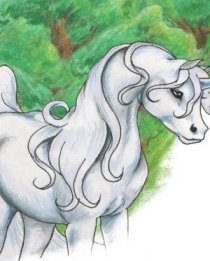
 Main
Main
Silvanon Art
See the Map
Orchard Messagepost
Contact Information

Drawing Tutorials: Circle Horse
This tutorial shows a method of drawing an equine using circles and lines. Start off by drawing two circles. They should be the same size, and make sure that they are level horizontally (as shown by the green lines below.) The image below has a blue line showing the approximate radius of the circles, and an orange line showing the distance between the circles. Notice that the blue and orange lines are approximately the same length.
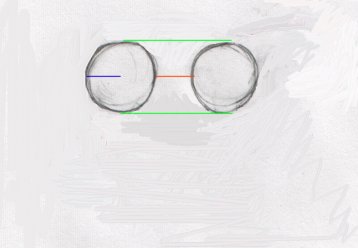
Now draw two lines to connect the circles. Notice that both lines curve slightly downward, but the bottom line curves more. The curve of the bottom line is closer to the righ hand circle--the right hand circle will be the front half of our horse.
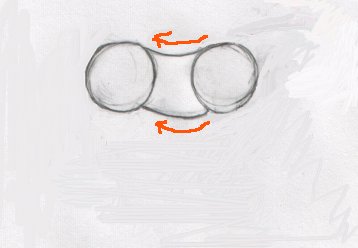
Now we will draw the neck of our horse. The neck is slightly wider near the body, and narrows a bit towards the head. The top line of the neck has a slight upward arch, the bottom line has more of an arch. Notice the length of the neck, as measured in the center, is about the same as the width between our body circles.
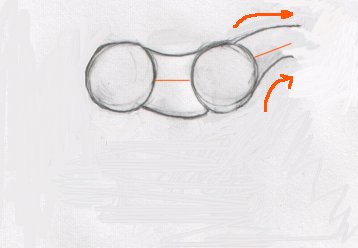
Now draw a circle on the end of the neck to start the head. The circle will be slightly wider than the end of the neck.
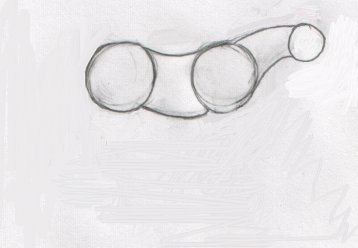
Now draw the nose. The nose will be slightly narrower at the end than at the base. Notice that the top of the nose rounds down a bit. The chin has a slight cup-shape to it.
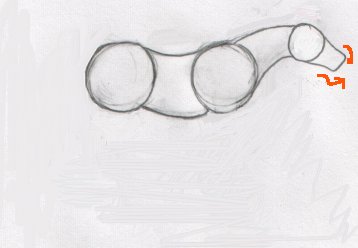
Now draw two small circles for the knees of the horse. They should be about level horizontally. Notice how the back knee is aligned with the back of the rear circle. The front knee is centered under the front circle. The distance to the knee circles is slightly less than the distance between the body circles.
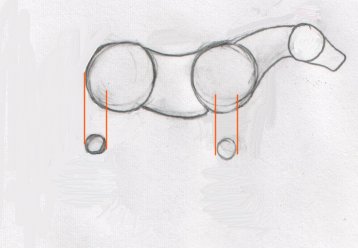
Now draw the upper portions of the legs. Notice the different curves of the lines, as emphasized by the orange arrows below.
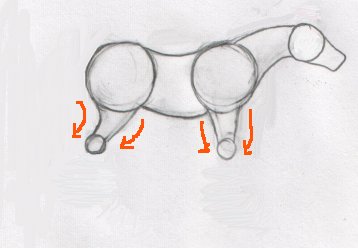
Now we will draw the lower legs, ending in circles for the ankles. The ankels are directly below the knees. The distance between the knees and the ankles is the same as the distance between the body circles. The leg between the knee and the ankle curves in ~very~ slightly.
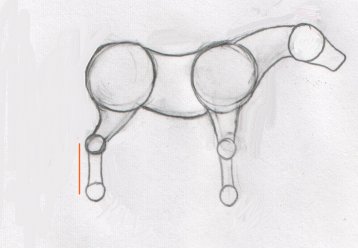
Next draw the last portion of the leg. Notice the angle of this portion, as demonstrated by the blue line. Also note the length is about the same as the width of the ankle circle. This portion of the leg flares a bit at the end (note the curves as emphasized by the orange lines).
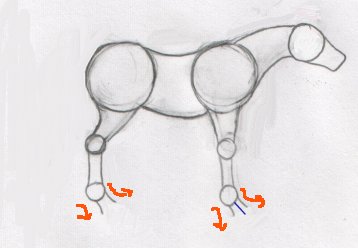
Now add on the hooves. Notice the triangle shape of the hooves. The top of the hoof follows the same angle as the leg. The bottom of the hoof curves down slightly. Notice that the back of the hoof is very thin--there is little hoof between the leg and the ground at the back.
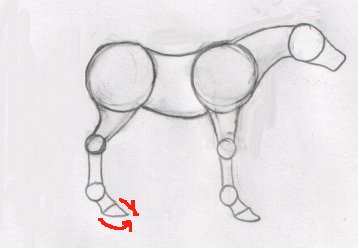
Now let's add some detail to the face. Draw a light line in the face circle, following the angle of the head, cutting the circle in half. The eye goes above this line. Notice that the eye is in the top right quarter of the head circle. The shape of the eye is detailed in red on the left. The nostril shape is detailed in red below that--notice the tear-drop shape.
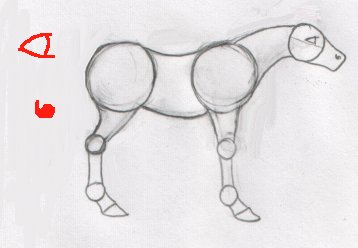
Now let's add the ears. The ears connect to the head at the point where the neck meets the head circle. The shape of the ears is detailed in red on the left.
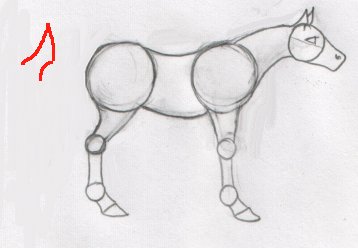
Time for a mane and tail. The tail can have two different shapes, as show by the two different lines below. The flow of the tail is emphasized by the red lines. Notice that the tail begins at about the same horizontal height as where the top body line connects to the back circle. The mane starts just below the ears, and extends over about half of the front body circle. It can fall to either side of the neck. Have fun with your mane's shape!

Finally, add a bit of shading and muscle definition, add in the two missing legs, define the shoulder box, and erase the circle lines. Add in a mouth--the mouth line goes just below the center of the nose.
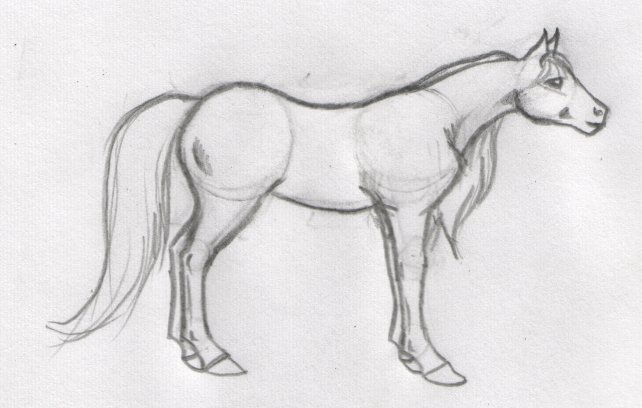
The picture above needs a bit more erasing--I should have drawn the initial circles much ligher so they would be easy to erase.
Page last updated: Mon, Aug. 4, 2003
Page made: Mon, Aug. 4, 2003
All images, content and layouts © Copyright Silvanon 2003, unless otherwise identified. No images or content on this site may be used without express written permission.
. . . . . . . . . . . . . . . . . . . . . . . . . . . . . . . . . . . . . . . . . . . . . . . . . . . . . . .. . . . . . . . . . . . . . . . . . . . . . . . . . . . . . . . . . . . . . . . . . . . . . .. . . . . . . . . . . . . . . . . . . . . . . . . . . . . . . . . . . . . . . . . . . .. . . . . . .. . . . . . . . . . . . . . . . . . . . . . . . . . . . . . . . . . . . . . . . . . . . . . . . . . . . . . . . . . . . . . . . . . . . . . . . . . . . . . . . . . . . . . . . . . .. . . . . . . . . . . . . . . . . . . . . . . . . . . . . . . . . . . . . . . . . . . . . . .. . . . . . . . . . . . . . . . . . . . . . . . . . . . . . . . . . . . . . . . . . . .. . . . . . .. . . . . . . . . . . . . . . . . . . . . . . . . . . . . . . . . . . . . . . . . . . . .. . . . .. . . . . .. . . . . .. . . . . . . .. .